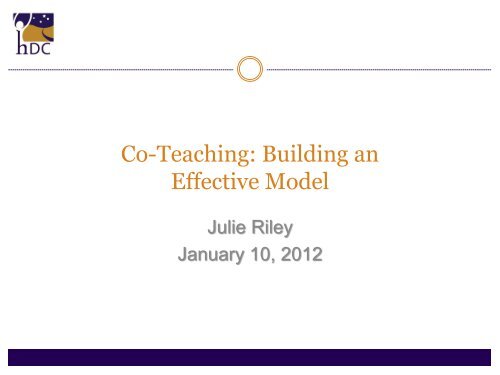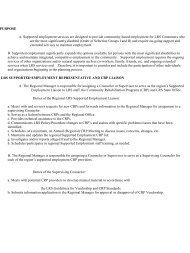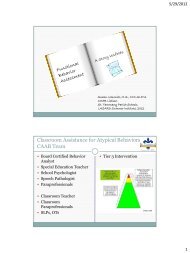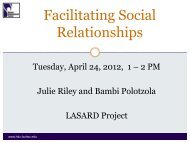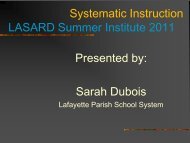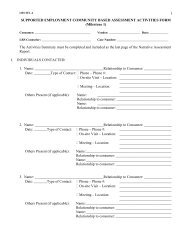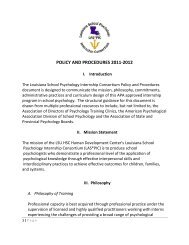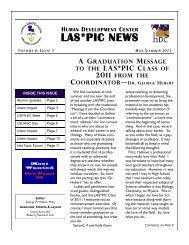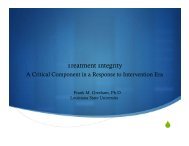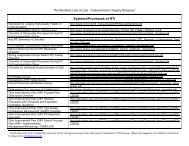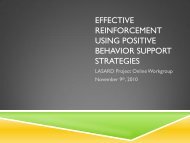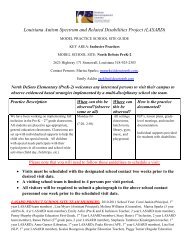Co-Teaching: Building an Effective Model
Co-Teaching: Building an Effective Model
Co-Teaching: Building an Effective Model
- No tags were found...
You also want an ePaper? Increase the reach of your titles
YUMPU automatically turns print PDFs into web optimized ePapers that Google loves.
ObjectivesParticip<strong>an</strong>ts will:• Learn basics of co-teaching, including approaches touse in the classroom• Recognize administrative support necessary for coteaching• Explore available co-teaching resources
Agenda• Define co-teaching• Benefits for teachers <strong>an</strong>d students• Administrative support• Approaches to co-teaching• <strong>Co</strong>-pl<strong>an</strong>ning• Utilizing paraeducators
Definition of co-teaching• Both share responsibility for pl<strong>an</strong>ning, deliveringinstruction, assessment, <strong>an</strong>d classroomm<strong>an</strong>agement.• Both share responsibility for providing supports <strong>an</strong>daccommodations to meet the needs of ALL studentsin the classroom.LA DOE (2011)
ParityHow to communicate to students that both teachersare equals?Names are bothposted onboard/inclassroomSimilar furniture(desks, chairs,etc.)Both participatein gradingBoth work withALL studentsEquivalentteacher talkduring class<strong>Co</strong>ok & Friend (2004) in LA DOE(2011)
Louisi<strong>an</strong>a Autism Quality Indicators• I1. Evidence of collaboration between special education<strong>an</strong>d general education teachers is present on lesson pl<strong>an</strong>s.• I3. Assessment of student work <strong>an</strong>d progress reflects inputfrom multiple team members.• I14. As needed, individualized supports in the generaleducation classroom are delivered by more th<strong>an</strong> twofaculty/staff/peers.
Shared responsibilitiesInstructionAdvocacyAssessmentData <strong>Co</strong>llection<strong>an</strong>dRecordkeepingM<strong>an</strong>agement ofBehavior<strong>Co</strong>mmunicationAccommodations<strong>an</strong>d ModificationsParticipation in<strong>Co</strong>nferencesLA DOE (2011)
Benefits of co-teaching for the students• Placement in LRE• Higher expectations• Enh<strong>an</strong>ced positive social outcomes• Increased engagement <strong>an</strong>d involvement• Access to models of adults working cooperatively<strong>an</strong>d adults dealing with disagreements• More realistic classroom communities for allstudents.LA DOE (2011)
• St. Pierre <strong>an</strong>d Catal<strong>an</strong>nottoVideo clip 1
Benefits of co-teaching for the teachers• Increases teacher satisfaction• Enh<strong>an</strong>ced opportunities for professional growth• Decreased feelings of isolation• Mutual appreciation of roles• More opportunities for creativity• More time for explicit teaching• Share responsibilities for workload• Reduced behavior problemsLA DOE 2011
• St. Pierre <strong>an</strong>d Catal<strong>an</strong>nottoVideo clip 2
ResourceFound at:http://www.lasig2.org/files/FINALcoteaching_Guide.pdf
Administrative support• Scheduling◦ Students◦ Teachers <strong>Teaching</strong> schedules <strong>Co</strong>mmon pl<strong>an</strong>ning time
ResourceLASARD AutismTraining Modules:<strong>Co</strong>llaborationFound at: www.hdc.lsuhsc.eduFollow to the LASARDpage, then click onAutism TrainingModules
<strong>Co</strong>-teaching approaches• Station <strong>Teaching</strong>• Parallel <strong>Teaching</strong>• Alternative <strong>Teaching</strong>• Teaming• One Teach, One Observe• One Teach, One AssistFriend, 2008
Station <strong>Teaching</strong>• Use? Frequent• What? Small group instruction. 3 groups – eachteacher with a group <strong>an</strong>d one independent.Students rotate <strong>an</strong>d visit all stations.Teacher 1IndependentGroupTeacher 2Friend, 2008
Station <strong>Teaching</strong> Example• During <strong>an</strong> elementary math class, students arelearning about estimating. The students are dividedinto 3 groups <strong>an</strong>d all students rotate to all 3 stations.◦ Group 1: Estimating dist<strong>an</strong>ce – how m<strong>an</strong>y feet wide is theclassroom – with teacher◦ Group 2: Estimating repetitions – how m<strong>an</strong>y times you c<strong>an</strong>jump in 1 minutes – with teacher◦ Group 3 – Estimating mass – how m<strong>an</strong>y crayons to bal<strong>an</strong>cethe weight on the scale – students work with a partner
Parallel <strong>Teaching</strong>• Use? Frequent• What? Teachers divide the class into 2 groups; eachlead same instruction for both groupsFriend, 2008
Parallel <strong>Teaching</strong> Example• In a 6 th grade L<strong>an</strong>guage Arts class, the studentshave read the first 4 chapters of Where the Red FernGrows. The teachers divide the students into 2heterogeneous groups, with students in each groupthat tend to talk frequently in discussions <strong>an</strong>d thosewho tend to be quiet. Once in the 2 groups, theteachers discuss the same questions to checkcomprehension <strong>an</strong>d explore the themes of the book.
Link to video• http://www.youtube.com/watch?v=hadT55umZU0&feature=related
Alternative <strong>Teaching</strong>• Use? Occasional• What? One teacher teaches to a large group whileother takes a small group for specific instructionalpurpose.Friend, 2008
Alternative <strong>Teaching</strong> ExampleIn a high school geography class, the teachersdetermine a small group of students would benefitfrom direct pre-teaching on the vocabulary to becovered. Some of the students in this group haveIEPs, <strong>an</strong>d some not. While some studentsindependently complete a worksheet finding thedefinitions in the book (monitored by the specialeducation teacher), the general education teacherworks with the small group to target the vocabularyvisually <strong>an</strong>d orally.
Teaming• Use? Occasional• What? Both teachers in front of classroom. Bothteachers fully engaged in delivery of the coreinstruction.Friend, 2008
Teaming ExampleAt the beginning of <strong>an</strong> algebra class, the specialeducation teacher leads during review of materialcovered <strong>an</strong>d the general education teacherdemonstrates concepts on the smartboard <strong>an</strong>d asksquestions. The general education teacher then takesthe lead introducing a new concept, <strong>an</strong>d the specialeducation teacher moves to the smartboard to workexamples <strong>an</strong>d ask questions.
One Teach, One Observe• Use? Occasional• What? Data gathered on academic, behavior, <strong>an</strong>d/orsocial skills• When? Periodically as concerns arise (e.g.,disruptive behaviors) or specific types of informationneed to be gathered (e.g., student sentence useduring group discussions).Friend, 2008
One <strong>Teaching</strong>, One Assisting• Use: Seldom• What? One teacher leads instruction while otherprovides support (e.g., monitors student work,addresses behavior issues, <strong>an</strong>swers studentquestions)Friend, 2008
One Teach, One Assist exampleDuring a science lab, the general education teacherprovides instruction <strong>an</strong>d directions regarding <strong>an</strong>experiment, <strong>an</strong>d the special education teacher movesaround the classroom to monitor if each student iscompleting the experiment correctly.
<strong>Co</strong>-teaching approaches• Try a variety of approaches, even in the same day• Don’t rely on “one teach, one assist” too frequently◦ Role of support teacher becomes more like a paraprofessional◦ Students don’t benefit from having 2 credentialed teachers inthe classroomFriend, 2008
Review of co-teaching approachesWhile Ms. Acker reviews yesterday’s homework withmost of the students, Ms. Vaugh<strong>an</strong> works with a smallgroup of students to review concepts they did notmaster on <strong>an</strong> assessment.◦ Team <strong>Teaching</strong>◦ Parallel <strong>Teaching</strong>◦ Alternative <strong>Teaching</strong>◦ Station <strong>Teaching</strong>
Review of co-teaching approachesMr. Johnson leads a small group of studentsdiscussing a novel about the industrial revolution. Ms.Boxer leads a small group to review material from thetextbook. Another small group independentlyexamines old newspapers <strong>an</strong>d pictures from the early1900s. The students rotate to all 3 groups.◦ Team <strong>Teaching</strong>◦ Parallel <strong>Teaching</strong>◦ Alternative <strong>Teaching</strong>◦ Station <strong>Teaching</strong>
Pl<strong>an</strong>ning Process ExampleGen ed <strong>an</strong>d special edteachers decide which coteachingapproaches to use,how to group students, whichaspects of the instructionmay pose difficulties, <strong>an</strong>dwhich projects may beoverwhelming for students.Individual studentsdiscussed.Friend, 2008During themeeting:Before themeeting:After themeeting:Gen ed teacher gathers keyinfo about upcomingcurriculum, projects, &activities <strong>an</strong>d brings this tothe meetingSpecial education teacherprepares the differentiatedmaterials <strong>an</strong>d strategiesnecessary for the instruction,pl<strong>an</strong> for meeting IEP goals withinthe curriculum.
Sample Pl<strong>an</strong>ning AgendaSample for 1 hour pl<strong>an</strong>ning periodUpcoming curriculumtopics/units/lessons<strong>Co</strong>-teaching arr<strong>an</strong>gements <strong>an</strong>dassignmentsChallenges <strong>an</strong>d strategies to helpstudents succeedIndividual student matters8 min17 min15 min15 minHousekeeping/Logistics5 minFriend, 2008, p. 149
Lesson Pl<strong>an</strong>ning ExampleDieker, 2006, pp. 2-3
Utilizing Paraeducators inGeneral Education Classroom• Work with small groups of students• Review concepts previously taught• Assist with monitoring students• Creating worksheets/m<strong>an</strong>ipulatives/other materialsas teacher directs• Supporting ALL students as directedFriend, 2008
Utilizing Paraeducators• <strong>Co</strong>-teaching involves 2 certified teachers – not ateacher <strong>an</strong>d paraeducator• Paraeducators should not be responsible for largegroup instruction, pl<strong>an</strong>ning or delivering initialinstruction, interpret assessment results, makeinstructional decisions, nor assume primaryresponsibility for a group of studentsFrench (2003) as cited in Friend (2008)
Wrapping up…• <strong>Co</strong>-teaching involved shared responsibility between2 teachers to meet the needs of ALL students in theclassroom.• Administrative support is import<strong>an</strong>t to the success ofco-teaching.• There are 6 approaches to co-teaching.• <strong>Co</strong>-pl<strong>an</strong>ning is key!• Use paraeducators to support students as directed.
Q&A
Resources• Maryl<strong>an</strong>d’s <strong>Co</strong>-<strong>Teaching</strong> Network◦ http://olms.cte.jhu.edu/20619• K8 Access Center <strong>Co</strong>-teaching Archives◦ http://www.k8accesscenter.org/index.php/category/co-teaching• <strong>Co</strong>-<strong>Teaching</strong> <strong>Co</strong>nnection◦ http://coteach.com/• Power of 2 resources◦ http://www.powerof2.org/
ReferencesDieker, L. (2006). The co-teaching lesson pl<strong>an</strong> book (3 rd ed.). Whitefish Bay, WI:Knowledge by Design.Friend, M. (2008). <strong>Co</strong>-teach! A m<strong>an</strong>ual for creating <strong>an</strong>d sustaining classroompartnerships in inclusive schools. Greensboro, NC: Marilyn Friend, Inc.Louisi<strong>an</strong>a Department of Education (2011). Louisi<strong>an</strong>a’s co-teaching resourceguide. Retrieved fromhttp://www.lasig2.org/files/FINALcoteaching_Guide.pdfMurawski, W. W., & Dieker, L. A. (2004). Tips <strong>an</strong>d strategies for co-teaching at thesecondary level. TEACHING Exceptional Children, 36(5), 52-58.


